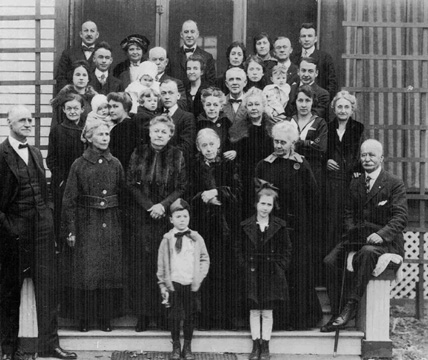
Puterbaugh-Parmelee Family Reunion, December 25, 1919. Fay Ady is standing at the far left end of the second row next to Joe Ady (the baby in the white cap) who is being held by his mother, Marie Ady. Next to Marie Ady is Howard Ady, Jr., who is being held by his father, Howard Ady.
For larger photo click on the picture,
it may take awhile.
______________________________________________________________
Miss Fay Ady
"Auntie Fay"
Article by Ernestine Orrick Van Buren
Photograph courtesy of Mrs. Martha Huff Truax
The R. C. Orrick family moved into a newly completed white frame
house in the Malakoff Fuel Company Addition in the summer of
1927. Our house was the first house on the east end of the middle
street in the addition.
Across from the Orrick home lived the Howard Ady family--Marie
and Howard and their sons, "Junior" and
"Joey" Ady. Several months after the Orricks moved into
their home, a new member of the Ady family arrived. She was
Howard Ady's sister, Miss Fay Ady. (The Ady's were first cousins
of W. D. and Jay Puterbaugh). Fay was blind and her blindness
fascinated the children in the neighborhood.
From our vantage spot across the street, my sisters and I would
watch with curiosity and interest as Miss Ady would walk from her
front porch, down two steps, down the center walk to the concrete
sidewalk, which was parallel to the paved street. We could not
understand how she knew just when to turn as she walked from the
house, turned to the right, and proceeded down the street to
visit with her cousins, the George Huff family. Then she reversed
her path to return to her front porch. When she was safely
indoors, we would practice the same routine with our eyes closed.
It wasn't easy! We had to count our steps carefully.
Soon after her arrival, my sisters and I were invited to visit
with Miss Ady on the Ady front porch. We discovered that she was
pleasant and cheerful, and she suggested that we call her
"Auntie Fay" just as "June" (Howard Ady, Jr.)
and Joe Ady called her. She played the piano, sang, told us
stories and recited poetry. Some of her poems were collected and
published. One poem I still remember was the following:
OLD GIANT DESPAIR
Old Giant Despair met a poor little girl
And he frightened her one day
By telling her all the bad things that he knew
And the world seemed saddened and gray.
But just then her old friend Hope came by
And the world seemed happy and gay.
Old Giant Despair gave an angry growl
And hurriedly walked away.
But the most fascinating thing Auntie Fay did was read stories to
us from her huge Braille books. We learned that she had become
blind after suffering meningitis when she was two years old. Her
family "home schooled" her during her early life; as a
teenager she was enrolled in the Perkins School for the Blind in
Boston. There she mastered Braille. Auntie Fay would guide our
hands across the perforations in her big Braille books,
introducing us to the technique of reading by touch. One book I
especially recall Auntie Fay’s reading to us was
"Little Women."
Auntie Fay sometimes expressed regret about not completing her
education when she was young. She felt she could have become a
teacher and supported herself. She was certainly a
wonderful teacher for her neighborhood children.
As we became more at ease in her presence, we sometimes indulged
in quite disrespectful antics, confident that Auntie Fay could
not see what we were doing. Soon we learned that she possessed a
"sixth sense." She knew when we were misbehaving and
quickly squelched our naughtiness. She commanded our respect
always.
One day, to express understanding of some subject, I
unintentionally used a phrase I had learned, "'I see,' said
the blind man." Without a pause, Auntie Fay responded,
"'You're a liar,' cried the dumb." I was embarrassed,
and I never used, "'I see', said the blind man" again
to express comprehension.
Visiting with Auntie Fay became an important activity on long
summer days in Malakoff in the early 1930s. She was cordial to
all the neighborhood children. The Patton twins, Margie Lou and
Margaret Sue, lived next door; farther down the street were
Robbie Moore Anderson and Martha Huff. The younger Mitchell
girls, Doris, Jean and Bettie, who lived in the first house on
the east end of the first street, often joined the group. But the
neighborhood children grew up and scattered. Auntie Fay became
ill and went to live in a nursing home in Colorado Springs. Later
we learned of her death, and "a light" went out of our
lives.
| Reprinted with permission by Britt Thompson If you have any information on Malakoff history please contact Britt, he is the correspondent for The Malakoff News Looking Back Column. |
Back To Henderson County TXGenWeb
This site is owned and maintained by the Henderson Co. TXGenWeb Co. Coordinator. Content of this site has been gathered from many sources and transcribed records. Therefore, errors may occur. When in doubt as to the accuracy of data contained herein, go to the actual records yourself. If you find any inaccurate data, please let us know. The information contained in this website is for your personal use only. All pages, compilations, transcriptions and abstracts are protected by copyright law and may not be published in whole or in part without written consent of the author, contributor and/or webmaster.
© Copyright 2001 - Present Bunny Freeman